The iPad Air Review
by Anand Lal Shimpi on October 29, 2013 9:00 PM ESTiPhone to iPad: CPU Changes
Although the iPad Air uses the same A7 from the iPhone 5s (and M7 motion coprocessor), there are a few minor differences that do lead to better performance.
At a high level we’re still talking about two 64-bit Apple Cyclone cores with 128KB L1s (64KB I$ + 64KB D$) per core, a shared 1MB L2 cache and a 4MB L3 cache that services the entire SoC. Apple increased CPU frequency from 1.3GHz to 1.4GHz in the iPad Air, a mild increase but in line with what we’ve seen from previous iPad designs. That’s the first impact on performance - a 7.69% increase in CPU frequency.
The second impact on performance is something I only noticed while digging around under the hood of the A7. It seems like the implementation in the iPad Air can, for whatever reason, hold more instructions in flight (over 20% more) than the A7 in the iPhone 5s. It’s unclear to me whether the A7 in the iPad is configured any differently via firmware/microcode or if perhaps we’re looking at a slightly different revision of the core, but the delta was repeatable in my testing.
The third, and likely biggest change impacting the iPad Air’s implementation of the A7 is the additional thermal headroom afforded by the larger chassis. I’m not going to go into details on exactly what this next test does (unfortunately we’re going to occlude some of the low level work that we do in light of all of the benchmark cheating going on), but we’re looking at a curve of performance vs. time for a particularly power heavy mix of code. We’re running the same exact code on both the iPad Air and iPhone 5s here, the only real difference is the size of the chassis:
You can see the 5s throttles back its CPU frequency to about 1GHz after the 2 minute mark. The crazy thing is that until that point the 5s manages to run at full frequency without so much as a hiccup for two full minutes, running an incredibly power hungry task. Given that most iOS apps aren’t this power intensive for such a sustained period of time, iPhone 5s users should almost always see the A7 running at a full 1.3GHz. Pretty crazy.
The iPad Air by comparison shows much more controlled behavior. Early on in the test we see a 7.7% performance advantage, which lines up perfectly with the iPad Air’s 7.7% CPU frequency advantage. By the end of the test the iPhone 5s has throttled to 900MHz, while the iPad Air drops to around 1.2GHz. At this point the iPad Air’s performance advantage grows to almost 40%.
CPU Performance
I've gone through our standard set of cross-platform browser based benchmarks to place the iPad Air's performance in perspective. As I mentioned in our 5s review, I don't know that there are many (any?) applications on iOS 7 that can really take advantage of all the A7 has to offer. There's definitely a ton of headroom left in the design. What's particularly exciting is when the A7 ends up in n-1 or n-2 iOS devices and it becomes the minimum developer target going forward.
I won't go through all of the results here again, but it's safe to say that the iPad Air is the fastest ARM based tablet on the planet at this point.
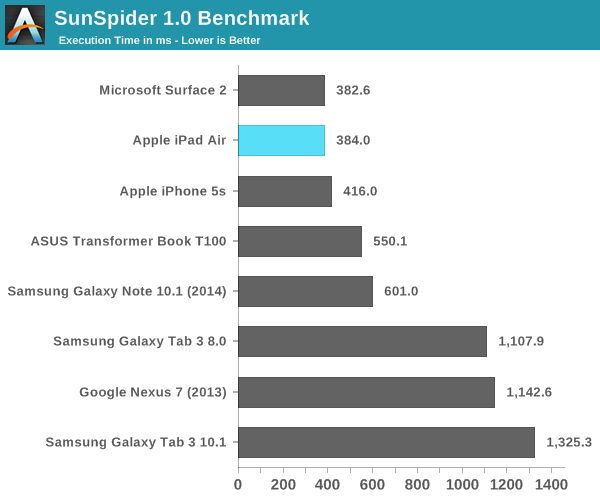
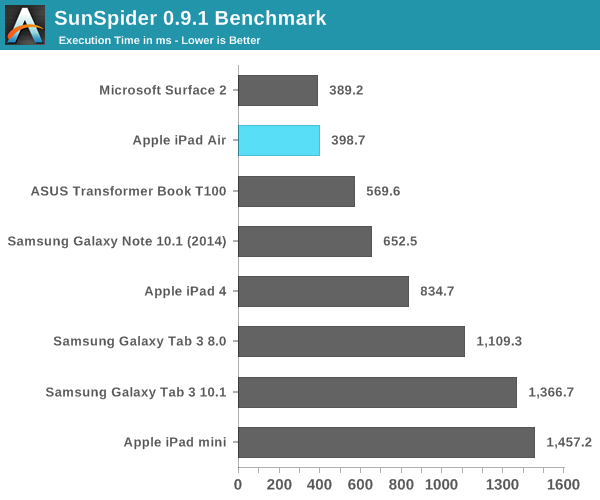
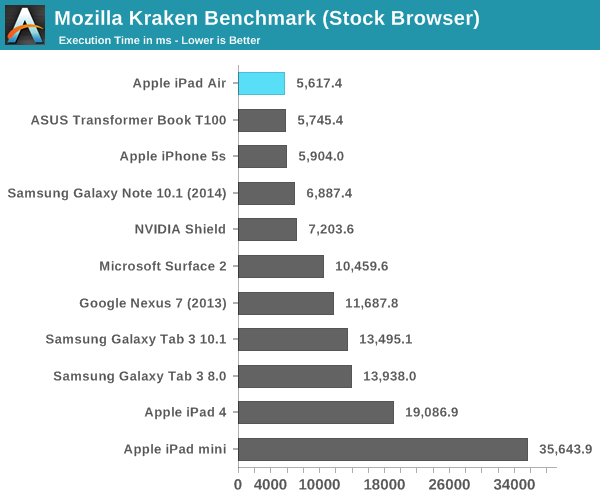
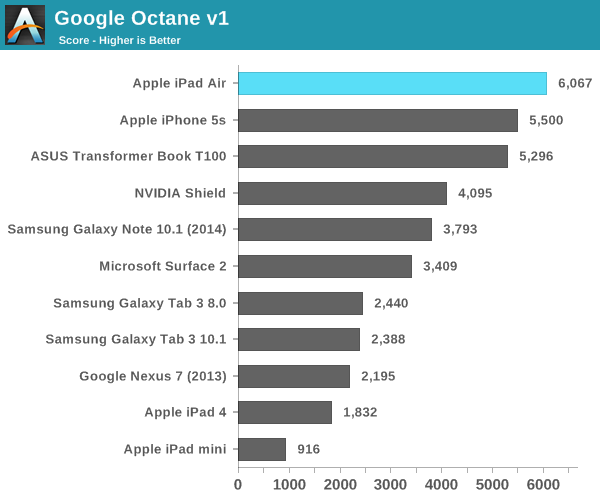
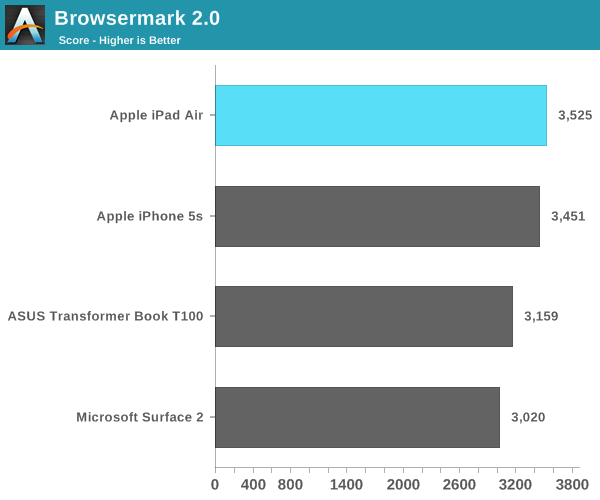

A7 Power Consumption
I’ll get to battery life in a bit, but I’ve been curious about the dynamic range of power consumption offered by Apple’s new A7 SoC. On the one hand we’re dealing with a lower power process (28nm vs. 32nm), but on the other hand Apple’s Cyclone cores can clearly draw more power given how beefy the architecture is this round. Apple frowns upon review sample dissection so I had to turn to a less scientific method of external platform level power measurement. The fidelity of the numbers here aren’t all that great but it’s better than nothing.
For the first test I measured platform power consumption during a Kraken run:
I purposely started measuring before the benchmark so I could get an idea of idle power consumption. The iPad Air consumes roughly 72% of the idle power as the iPad 4, both running at the same brightness. Here we’re not just seeing the A7’s advantages but also things like lower display power.
Focusing on the load portion of the measurement we see that both the new iPad and old iPad consume the same total power in this test. I suspect the A7 is drawing more power than the A6X, but it’s masked by a lower power display. Given how much faster the iPad Air is, Apple’s latest tablet features far lower overall task energy than the outgoing iPad 4. This is probably both the best case scenario for the iPad Air and the most likely case as well.
For kicks I wanted to see just how much power I could get the iPad Air to draw. Here I’m looking at platform power during our mini-power-virus test from above:
How’s that for dynamic range? Almost 12W running all out, but around half that in what we’d normally consider to be a stressful CPU test. I couldn’t get any actual applications/games on the iPad Air to behave like this so the results above are purely academic (for now). A quick run through GFXBench 2.7’s T-Rex HD test confirms that even pushing the GPU won’t hit these numbers. The max I saw running T-Rex offscreen was ~6W, and turning to an actual game (Infinity Blade 3) the iPad Air pulls less than 5W.


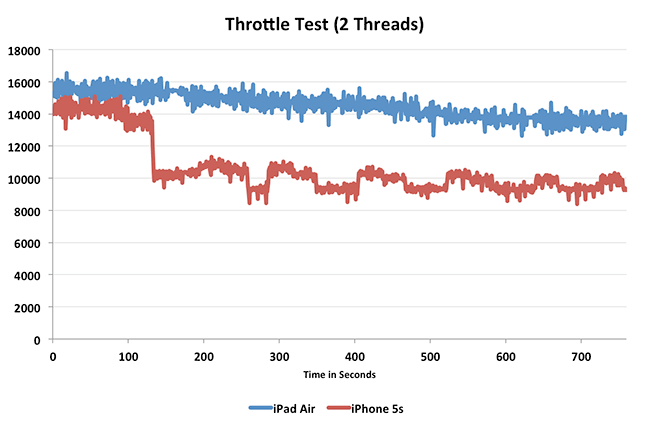
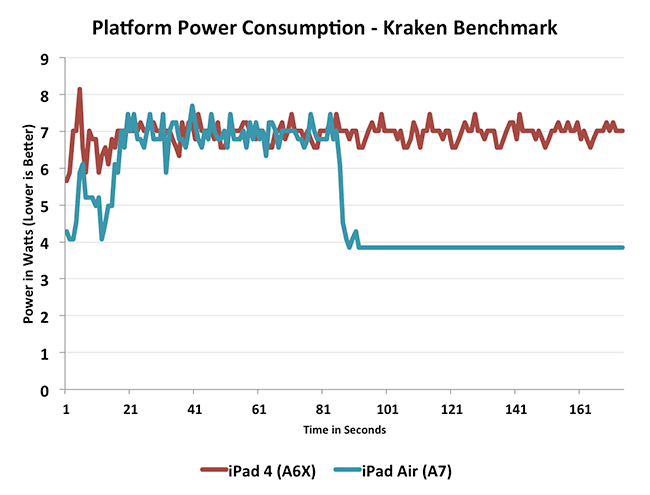
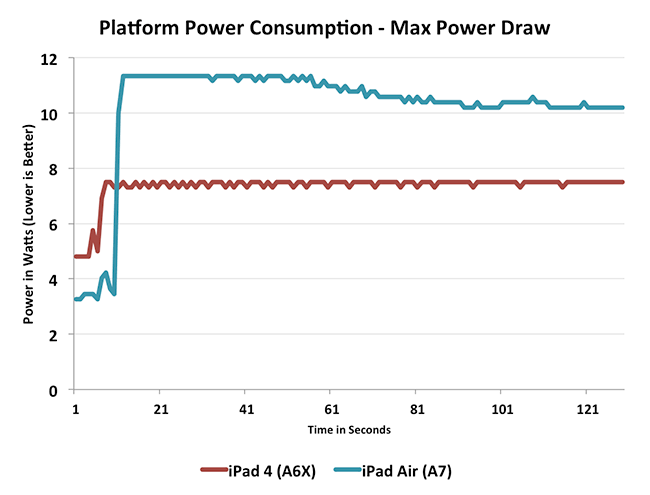








444 Comments
View All Comments
Krysto - Friday, November 1, 2013 - link
Why would the aspect ratio matter in calculating the surface area?thunng8 - Friday, November 1, 2013 - link
Of course aspect ratio affects areaTake an extreme example a tablet of length 25cm and width of 1cm. Surface area is 25cm^2. Diagonal is still 25cm. ( to be more precise 25.02cm).
gnx - Thursday, October 31, 2013 - link
As I mentioned, I find both a 7.9 inch ipad mini and galaxy note 8.0 (which is really closer to iPad Mini) both too cramped and small, as I use the table for foremost as a document reader on the go. And just to add, the Galaxy Tab 8.9 was 1280:800, thus 16:10, making even overall space closer to an iPad.Finally, for practically reasons, the Galaxy Tab 8.9 was nice, since because it's height in portrait mode was almost identical to an iPad 2/3/4, just narrower in breath, I could chose from most iPad accessories such as any carrying cases, pouches, bluetooth keyboard, etc.
yoshi1080 - Thursday, October 31, 2013 - link
I still love my iPad 3, but I'm thinking about upgrading. I do a lot of stuff on it and sometimes I wish it'd be faster. The iPad Air should be around 3–4x faster, right?Two of the most demanding tasks where I wish my iPad was faster are photo and video editing. I've already read that iMovie is supposed to be really fast on the iPad Air, so that's a clear advantage. My iPad's speed is sufficient for JPEG editing, but RAW processing (with PiRAWnha) is practically unusable. Processing RAW photos on my iPad would be my dream because photo editing on it is just so much more fun than on my iMac with the dreadfully slow Aperture – I'd be happy with getting 90% of the quality, but RAW is mandatory for me.
Up until now I thought the iPad Air would be much better suited for PiRAWnha. But now Anand writes about the RAM bottleneck due to the 64bit architecture and this makes me wonder: On the original iPad, the app often complained about too little available RAM and eventually crashed. I feel like the 1GB RAM on the iPad 3 is the reasonable minimum – would the Air be a disappointment in that regard? On the other hand, Adobe is working on bringing Lightroom and those smart DNGs to the iPad, and the beta version has even been shown running on an old iPad 2.
darkcrayon - Thursday, October 31, 2013 - link
Apps just don't need as much RAM as we think they do, especially mobile versions. Sometimes I'm surprised what can still run just fine on an iPad 2 (also helps of course that only one foreground app needs to run at a time). The Air should be 4 times faster than the iPad 3- should be no contest, especially in CPU.Death666Angel - Thursday, October 31, 2013 - link
Well, using one app at a time is fine, but browsing the web with a few tabs open and then switching to one or two other apps gets Apple device quickly ejecting stuff from RAM, where my Nexus devices are still having the pages loaded. :)fteoath64 - Thursday, October 31, 2013 - link
Thanks for the detailed review!. As I suspected the A7 behavior would have been rather different to wring out more performance out for the iPad as compared to the iphone. As you stated in the power consumption measurements, it seems the A7 is rather power hungry and only aggressive power management gets the battery life it needs. I am sure, it would be waiting for the TSMC 20nm process node as it seems this chip is just at the brink of 28nm as it is today. In making, the battery last so long without negatively impacting user performance, Apple has done a great job to achieve the balance using software. From the power draw alone, I figured out why it was clocked at such speeds instead of 1.6Ghz or 1.8Ghz. It cannot afford the power budget associated with it!.iwod - Thursday, October 31, 2013 - link
Sk Hynix Just announced a 6Gb LPDDR3. A Maximum of 3GB when 4 of them Stacked, Interesting isn't it?How about 2 Channel use? 1.5GB of Memory? May be a big company / customer would like / require this ?
While I hope Apple will give us 2GB in next generation. The reality may very well be we get 1.5GB of memory only.
bigup - Thursday, October 31, 2013 - link
is the 1GB RAM really a deal breaker? sold my ipad 3 to buy the iPad Air but now having seconds thoughts - what do you think?darkcrayon - Thursday, October 31, 2013 - link
It's not a deal breaker. You could argue in 2 years it would be better with more, but you're already the type of person that sells their less than 2 year old iPad for the latest, so... ;)